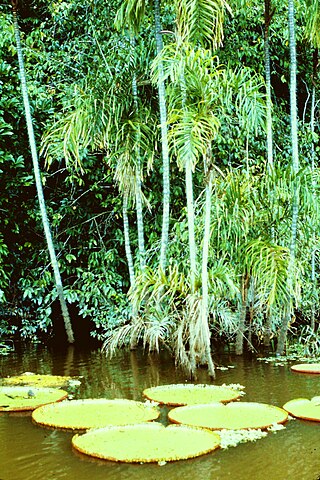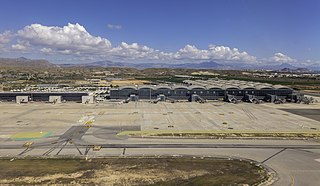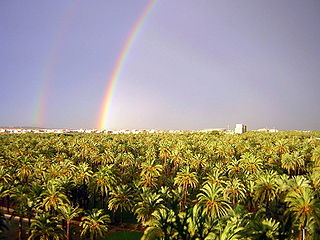Abiotic stress is the negative impact of non-living factors on the living organisms in a specific environment. The non-living variable must influence the environment beyond its normal range of variation to adversely affect the population performance or individual physiology of the organism in a significant way.

An ecosystem consists of all the organisms and the physical environment with which they interact. These biotic and abiotic components are linked together through nutrient cycles and energy flows. Energy enters the system through photosynthesis and is incorporated into plant tissue. By feeding on plants and on one another, animals play an important role in the movement of matter and energy through the system. They also influence the quantity of plant and microbial biomass present. By breaking down dead organic matter, decomposers release carbon back to the atmosphere and facilitate nutrient cycling by converting nutrients stored in dead biomass back to a form that can be readily used by plants and microbes.

A biotope is an area of uniform environmental conditions providing a living place for a specific assemblage of plants and animals. Biotope is almost synonymous with the term "habitat", which is more commonly used in English-speaking countries. However, in some countries these two terms are distinguished: the subject of a habitat is a population, the subject of a biotope is a biocoenosis or "biological community".

Elche is a city and municipality of Spain, belonging to the province of Alicante, in the Valencian Community. According to 2014 data, Elche has a population of 228,647 inhabitants, making it the third most populated municipality in the region and the 20th largest Spanish municipality. It is part of the comarca of Baix Vinalopó.
This glossary of ecology is a list of definitions of terms and concepts in ecology and related fields. For more specific definitions from other glossaries related to ecology, see Glossary of biology, Glossary of evolutionary biology, and Glossary of environmental science.

A green wall is a vertical built structure intentionally covered by vegetation. Green walls include a vertically applied growth medium such as soil, substitute substrate, or hydroculture felt; as well as an integrated hydration and fertigation delivery system. They are also referred to as living walls or vertical gardens, and widely associated with the delivery of many beneficial ecosystem services.
Realized niche width is a phrase relating to ecology, is defined by the actual space that an organism inhabits and the resources it can access as a result of limiting pressures from other species. An organism's ecological niche is determined by the biotic and abiotic factors that make up that specific ecosystem that allow that specific organism to survive there. The width of an organism's niche is set by the range of conditions a species is able to survive in that specific environment.
Ecotopes are the smallest ecologically distinct landscape features in a landscape mapping and classification system. As such, they represent relatively homogeneous, spatially explicit landscape functional units that are useful for stratifying landscapes into ecologically distinct features for the measurement and mapping of landscape structure, function and change.
In biology and ecology, abiotic components or abiotic factors are non-living chemical and physical parts of the environment that affect living organisms and the functioning of ecosystems. Abiotic factors and the phenomena associated with them underpin biology as a whole. They affect a plethora of species, in all forms of environmental conditions, such as marine or land animals. Humans can make or change abiotic factors in a species' environment. For instance, fertilizers can affect a snail's habitat, or the greenhouse gases which humans utilize can change marine pH levels.

An aquatic ecosystem is an ecosystem found in and around a body of water, in contrast to land-based terrestrial ecosystems. Aquatic ecosystems contain communities of organisms—aquatic life—that are dependent on each other and on their environment. The two main types of aquatic ecosystems are marine ecosystems and freshwater ecosystems. Freshwater ecosystems may be lentic ; lotic ; and wetlands.

Alicante–Elche Miguel Hernández Airport, , is an international airport located about 9 km (5.6 mi) southwest of the city of Alicante and about 10 kilometres east of the city of Elche in Spain. Alicante–Elche is one of the main airports in south-eastern Spain, serving both the southern part of the Valencian Community and the Region of Murcia.

River ecosystems are flowing waters that drain the landscape, and include the biotic (living) interactions amongst plants, animals and micro-organisms, as well as abiotic (nonliving) physical and chemical interactions of its many parts. River ecosystems are part of larger watershed networks or catchments, where smaller headwater streams drain into mid-size streams, which progressively drain into larger river networks. The major zones in river ecosystems are determined by the river bed's gradient or by the velocity of the current. Faster moving turbulent water typically contains greater concentrations of dissolved oxygen, which supports greater biodiversity than the slow-moving water of pools. These distinctions form the basis for the division of rivers into upland and lowland rivers.

A lake ecosystem or lacustrine ecosystem includes biotic (living) plants, animals and micro-organisms, as well as abiotic (non-living) physical and chemical interactions. Lake ecosystems are a prime example of lentic ecosystems, which include ponds, lakes and wetlands, and much of this article applies to lentic ecosystems in general. Lentic ecosystems can be compared with lotic ecosystems, which involve flowing terrestrial waters such as rivers and streams. Together, these two ecosystems are examples of freshwater ecosystems.
Soil ecology is the study of the interactions among soil organisms, and between biotic and abiotic aspects of the soil environment. It is particularly concerned with the cycling of nutrients, formation and stabilization of the pore structure, the spread and vitality of pathogens, and the biodiversity of this rich biological community.

The Palmeral or Palm Grove of Elche is the generic name for a system of date palm orchards in the city of Elche, Spain.
The following outline is provided as an overview of and topical guide to ecology:

An aquarium is a vivarium of any size having at least one transparent side in which aquatic plants or animals are kept and displayed. Fishkeepers use aquaria to keep fish, invertebrates, amphibians, aquatic reptiles, such as turtles, and aquatic plants. The term aquarium, coined by English naturalist Philip Henry Gosse, combines the Latin root aqua, meaning 'water', with the suffix -arium, meaning 'a place for relating to'.

The root microbiome is the dynamic community of microorganisms associated with plant roots. Because they are rich in a variety of carbon compounds, plant roots provide unique environments for a diverse assemblage of soil microorganisms, including bacteria, fungi and archaea. The microbial communities inside the root and in the rhizosphere are distinct from each other, and from the microbial communities of bulk soil, although there is some overlap in species composition.

Ignacio Solano Cabello is a Spanish biologist and landscaper who designs and builds green walls.

Alien species, or species that are not native, invade habitats and alter ecosystems around the world. Invasive species are only considered invasive if they are able to survive and sustain themselves in their new environment. A habitat and the environment around it has natural flaws that make them vulnerable to invasive species. The level of vulnerability of a habitat to invasions from outside species is defined as its invasibility. One must be careful not to get this confused with invasiveness, which relates to the species itself and its ability to invade an ecosystem.

















